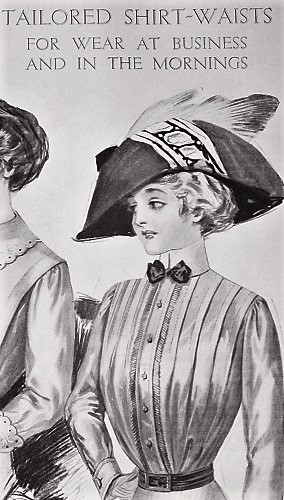
Shirt-waist from Delineator article, February 1910, p. 97.
I wish I could give a definitive answer to “What’s the difference between a ‘shirt-waist’ and a blouse or ‘waist?’ ”
But: fashion writing…. (sigh.) It’s not the most precise art.
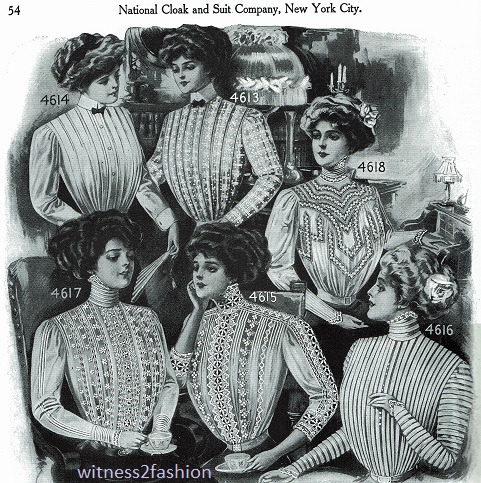
A mixture of “Shirt Waists” and “Waists” (sometimes called blouses.) Top of page 54, National Cloak & Suit catalog, 1909.
I thought I could pick out the “Shirt Waists” from this catalog at a glance. I was wrong. This page of women’s “waists” and “shirt-waists” from the National Cloak & Suit Company for 1909 (Dover Books: Women’s Fashions of the Early 1900s: An Unabridged Republication of New York Fashions, 1909) shows the confusion. (You can also find it as a PDF online.)
My instinct after pouring through books and magazines was to think that, if it unbuttons down the front, it’s a “shirt-waist.” But that’s probably because of the shirtwaist dresses I wore in the 1950s and 1960s. Those didn’t necessarily (or usually) button all the way down the front to the hem, but they always closed with buttons at least to the waist in front.
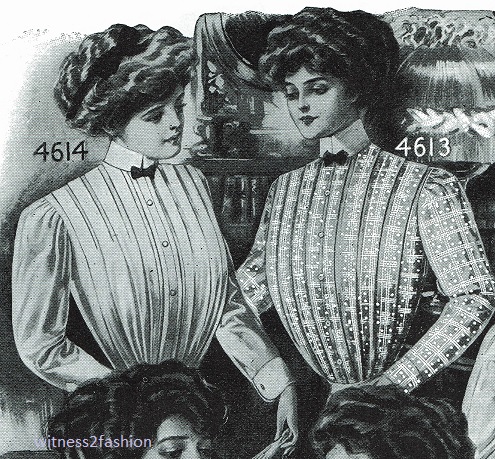
Left, Shirt Waist 4614. That’s what I was expecting.

I think most of us would recognize that No. 4614 (top left) is a “tailored shirt-waist,” “nattily mannish.” It visibly buttons down the front, and the collar opens in the center front, too. But what, exactly, makes it a Shirt Waist?
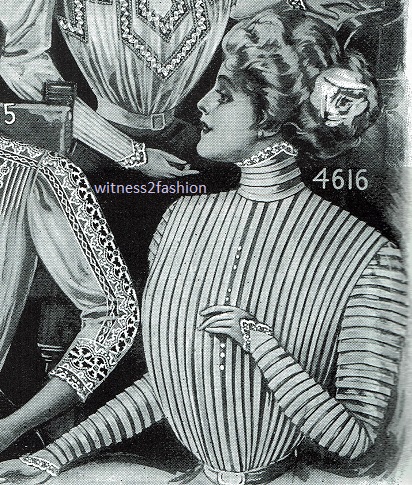
No. 4616 (on the same page) is also described as a “Shirt Waist.” [Although those buttons are purely decorative….]

No. 4616 is a “Tucked Shirt Waist of India Lawn.” “The front displays groups of tiny pearl buttons.” Does it actually open down the front? No. It “buttons in back.” Does the collar open in front? No. (Collars were often connected to the garment at one side, and opened at the side neck or back neck, being finished and hanging free where not attached. So the collar opening is inconclusive.) What makes it a Shirt Waist?

Shirt Waist 4614 and “Waist” No. 4613. What’s the difference? I don’t know.
No. 4613 (right, next to Shirt Waist 4614) has a “visible button closing in front” and a “detachable turn-over linen collar.” But it’s a “Waist.” Apparently a stiff detachable collar isn’t the criterion, either.
Maye I’m putting too much faith in the copy writer…. Or maybe it has to do with tucked pleats…?

Right, Shirt Waist 4625. But No. 4630, left of it, is described as a “Waist.” Page 56. Both are pleated…. And both really do button down the front — somehow.

Above: No. 4625 (at right) is a “Shirt Waist of Pure linen… mannishly finished with detachable stiff linen collar….” This one looks like a shirt-waist to me, too!
Below: a blouse waist and a shirt waist.
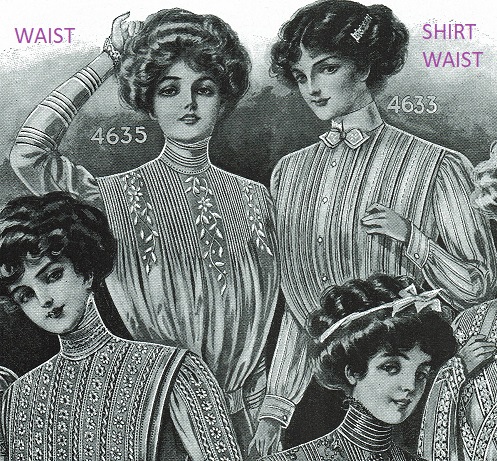
Right, Shirt Waist No. 4633. Left, Waist 4635. Yes! To me, No. 4635 looks like a blouse waist and 4633 looks like a shirt waist. (Page 57.) If only it were this simple.
No. 4633, above right, is a “Shirt Waist.” It “closes visibly with pearl buttons through a box-plait…..” and has “stiff link cuffs of the [striped shirt] material. Detachable linen collar.” And it’s pleated/tucked.

“Shirt Waist” No. 4641, from page 58.
No. 4641 is another “Shirt Waist” with button front opening and detachable collar. Embroidery and other feminine touches do not disqualify a “waist” from being a Shirt Waist. A Shirt Waist can even have a side front closing, like the one below. But it does seem to need full length sleeves, like a man’s business shirt.
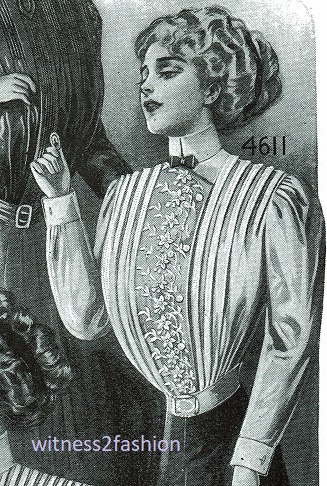
No. 4611 — with its asymmetrical closing, is still a Shirt Waist. Page 53.

On the other hand….
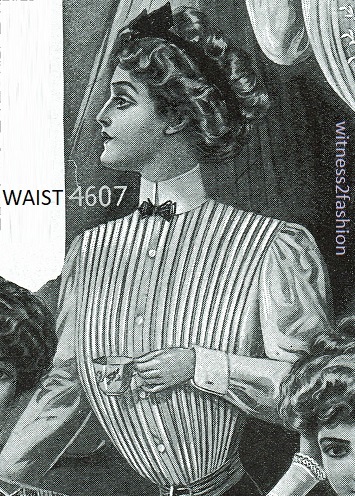
“Waist” No. 4607, page 58.
No. 4607, which “closes visibly with pearl buttons ” down the tucked front, and has a “detachable stiff linen collar” — [surely this is a shirt waist?] — is a “Waist of fine quality Linene.” A “Waist!”

At this point I began to consider the “all the news that fits the print” principle; the copy writer is required to squeeze the selling points into the available room for text, because this is a catalog. The word “Shirt” might be edited out to fit the space available. However, there seems to be plenty of room in that listing for more than one additional word! (That’s a long series of dots!)
So I went back to good old Delineator magazine. There, the same pattern may be described both ways, as is No. 3754, which is a “waist” in the illustration and a “shirt-waist” in the accompanying text.
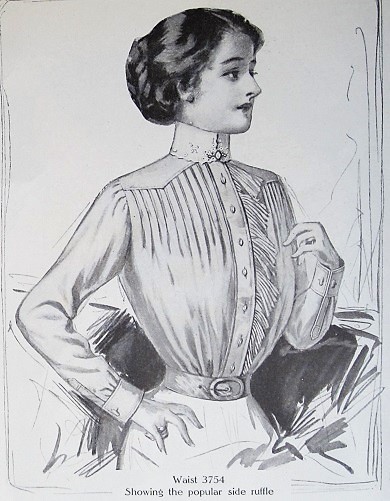
Butterick waist 3754, Delineator, April 1910, p. 294.

Butterick 3754 pattern description, Delineator, April 1910, page 294. “A new style of shirt-waist. No. 3754….”
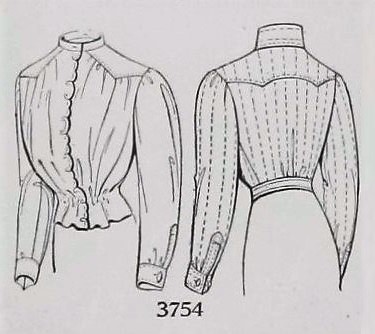
Alternate views of Butterick 3754. Delineator, April 1910, page 294. So many variations!
At least the Butterick “Waist” and “Shirt-Waist” patterns in Delineator have some justification for being described both ways: unlike a store-bought waist, a blouse/waist pattern could be made more than one way. The same blouse pattern might be made with the soft collar option or a stiff, detachable, turn-down collar. (And a collar like the one at left might be made separately and basted into place when wanted.) Other options were gathers instead of tucks, and either long or 3/4 sleeves.
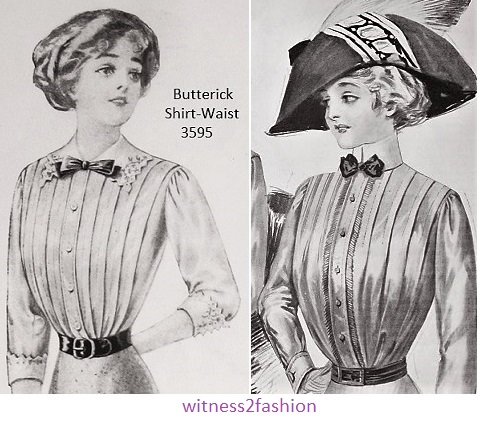
Butterick shirt-waist pattern 3595; two versions from February 1910.
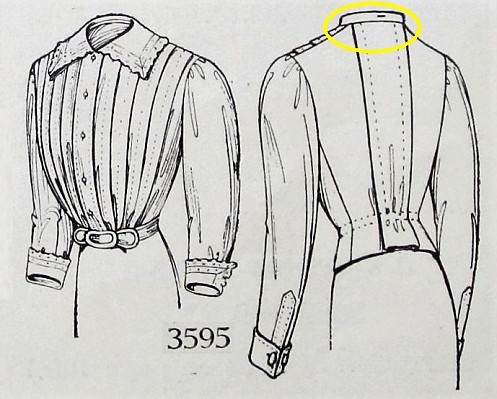
Two views of Butterick 3595: with attached collar (L) and ready for a detachable collar (R).
Notice the buttonhole in the back of the version on the right; it is ready to have a stiff, detachable collar secured with a collar button or stud, just like men’s business shirts.

Butterick Shirt-waist 3757, two views from April 1910. Page 297.
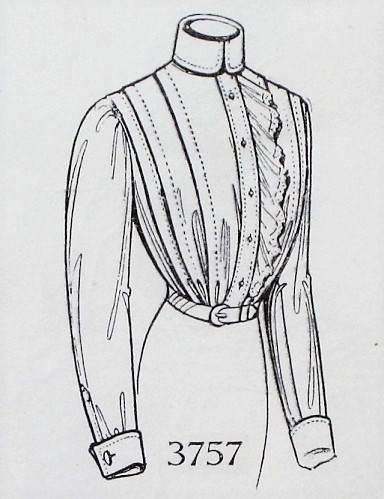
Another incarnation of Butterick Shirt-Waist 3757. The frill is probably a “button-in” option, as it was on No. 3754.
In this version, it opens down the front with a row of visible buttons, it has a stiff, detachable collar, it has stitched-down pleats or tucks, and long sleeves with French cuffs. But, as shown in its other views, … not necessarily!

One other thing to keep in mind: men’s shirts did not always open all the way down the front in the early 1900s. So the complete center front button opening on women’s waists may not be key to defining a “shirt waist.”
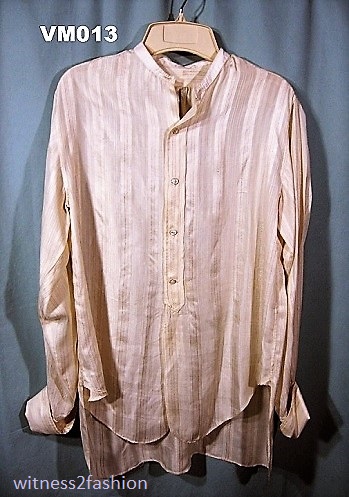
This man’s shirt has a CF button placket, but it doesn’t reach the bottom hem.
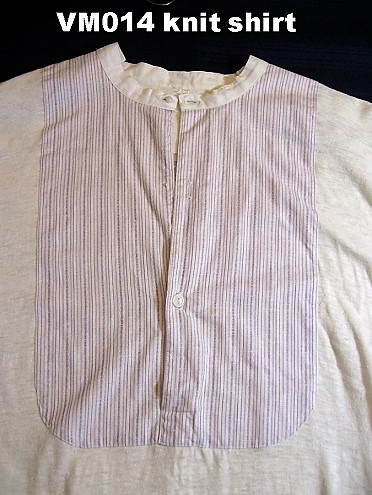
This man’s pull-on shirt has a striped bib with button placket, on a plain knit shirt.
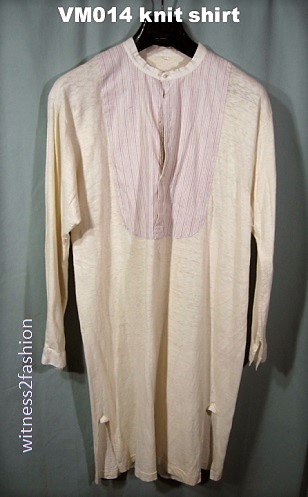
Man’s knit shirt with striped fabric bib.
In conclusion (and confusion) I present:
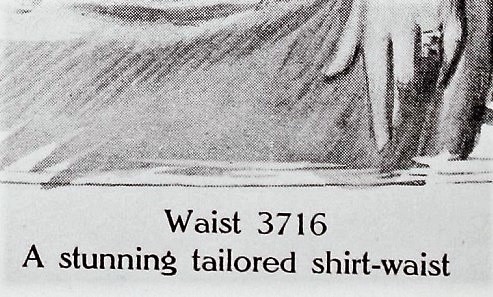
Caption for illustration of Butterick 3716. Delineator, April 1910. p. 295.
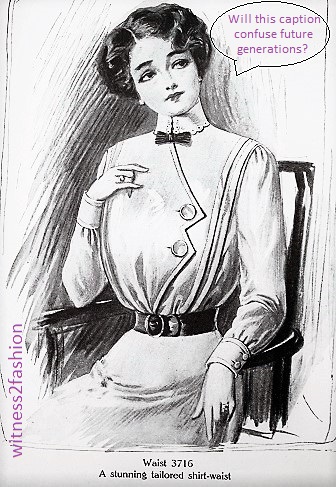
Is that what they were thinking? Delineator, April 1910, p. 295.
I’m looking forward to comments from anyone who can definitively define the women’s “shirt waist” for me 🙂
Click here for the Fashion Institute’s essay on shirtwaists. [EDIT 5/30/19; I asked and I received: for some very helpful suggestions — and the information that men’s shirts could also be called “shirt-waists” — see the comments below from Peter Pane!]
